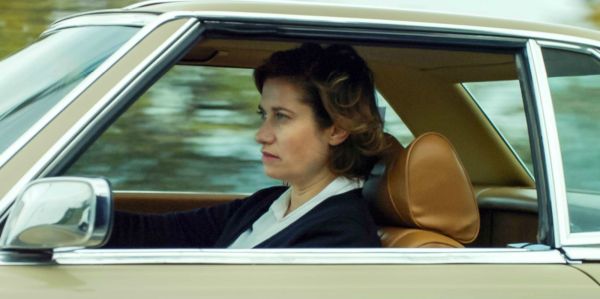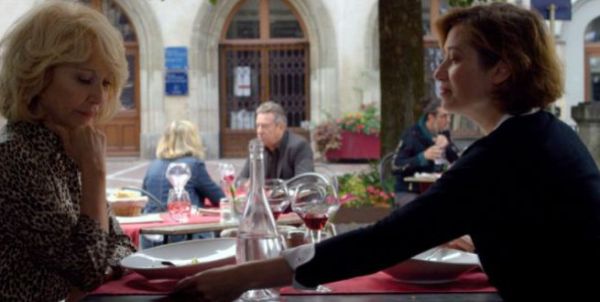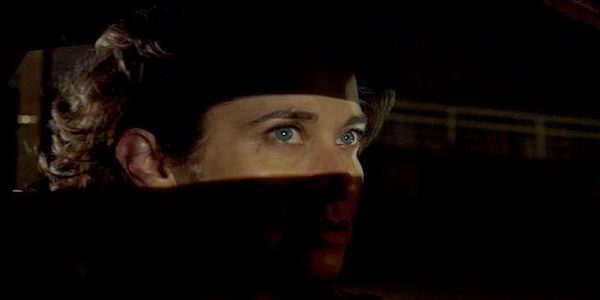MOKA: Motherhood, Grief & Revenge

Laura Birnbaum is a proud film critic and writer from…
You may be wondering how the euphonious title, Moka, plays into this film by Swiss director, Frédéric Mermoud. The title is simple but effective, referring to the creamy coffee-colored vintage car involved in a hit an run that is central to this slow-burn revenge story.
Based on the eponymous novel by Tatiana de Rosnay, we follow grief-stricken mother, Diane (Emmanuelle Devos), as she adamantly pursues her son’s killer who struck him with the car in question. She has grown weary of what she perceives to be an all-too languorous police pursuit of the responsible party and thus decides to take matters into her own hands.
This synopsis suggests a thriller (as do the screenshots), but despite any wilful attempts of my own, a thriller this is not. The tone wavers between the dramatic and the far less dramatic, though the intense staring throughout makes for a solid attempt at conjuring up suspense. Moka, however, is certainly not without success, it just happens to come with a few caveats.
Maternal Drive

The film opens as Diane approaches her hospital window. Dawn is breaking over nearby Lake Geneva, casting a cool blue light on her face as she presses and bangs her head gently against the window. We watch as she escapes the hospital, evading the nurses at their stations, and departs on a train. This opening scene sets up a foundational theme that flows over the film’s entirety – Diane is never where she is “supposed” to be.
Aided by a tip from a private detective, Diane obtains a list of cars that match eyewitness accounts of what struck and killed her son. Her obsessive pursuit of the car eventually leads her to the nearby town of Évian where she finds a mocha-colored vintage Mercedes owned by a local couple.
The couple are an an attractive pair; the wife, Marlène, a beauty consultant, (Nathalie Baye) and her husband Michel (David Clavel), a fitness instructor. Diane approaches and interacts with them separately, trying to buy the car in question from Michel while prying herself into a friendship with Marlène. We watch as Diane falls prey to her own emotions as her attempts to get close to the couple are executed clumsily.

Her awkwardness isn’t surprising. Diane isn’t a seasoned detective nor is she separate from the sorrow in the case. She is the mother – arguable as close to this crime as one can be. She is driven entirely by her despair, fueled by her grief and her fervor for justice.
Burning the Midnight Oil
I referred to Moka as a slow-burn, and that descriptor remains, though adding “ultra,” to the beginning of that might fit more appropriately. The pace to which this film burns could be paralleled to a campfire that has already reached its peak, its withering and orange-glowing embers sizzling quietly along the dramatic narrative.

f you’ve been following me for a while, you’re well aware of my particular affinity for slow-burning films such as Take Shelter, Prisoners, and other suspense-y things. While watching and analyzing Moka, I was reminded of another Swiss slow-burn that feels much in the same tonal vein, Clouds of Sils Maria by Olivier Assayas.
Both films approach the subject of loss in the Swiss Alps (a niche but sincerely appreciated pseudo sub-genre), both featuring strong female characters throughout. Where the films differ, however, is in their confidence. Moka feels weighed down by its ambiguity while Clouds of Sils Maria is elevated by it.
Diane’s cold and banal affect alienates the viewer when the story calls for just the opposite. Her circumstance invites sympathy, but her performance lacks the warmth to warrant it. We see flecks of dynamism in her risky flirtation with a younger, and potentially dangerous gentleman, but this storyline soon becomes entirely tangential to the main revenge story. I would have liked to see that aspect of the story fleshed out more.
Where the film provides levity is also the person on which we place our suspicions, the main suspect, Marlène. She is “moka,” – fitted with a creamy coffee-colored designer jacket, purse, and of course, car. She omits an approachable warmth, contrasting with ‘cold, dusky-blue,’ Diane. Of course this plays into the viewer’s moral experience because after all, she’s still a suspect.
In Conclusion
Moka is fascinating in its own way. It’s a film that, despite my misgivings, I couldn’t quite get myself to look away from. Perhaps it was the scenic landscape, the charming suspect at the forefront, or even the fancy cars. Most perplexing to me, however, is that I believe the reason for my captivation might just be that this is a film that deserves attention.
What is your favorite “slow-burn” film? Let me know down in the comments!
Moka has had limited release in Europe since 2016 and is just out in limited release in the US.
Does content like this matter to you?
Become a Member and support film journalism. Unlock access to all of Film Inquiry`s great articles. Join a community of like-minded readers who are passionate about cinema - get access to our private members Network, give back to independent filmmakers, and more.
Laura Birnbaum is a proud film critic and writer from Chicago. When she's not watching independent horror films, she's likely smoking a cigar on a rooftop somewhere, thinking about which indie horror film to watch next.













